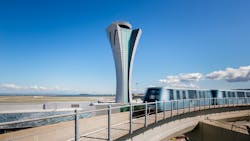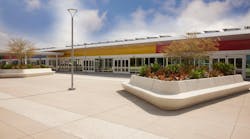Arup is leading San Francisco International Airport (SFO) to a greener future with the recent release of the airport’s Zero Net Energy Plan (ZNE).
The plan builds a roadmap for SFO leaders to reduce overall energy consumption across the airport’s 100-plus building campus while also sourcing 100 percent renewable energy to meet these demands.
Raphael Sperry, associate, sustainability consultant at Arup, said climate change poses specific risks to the airport and the ZNE plan wants to address them, particularly sea level rise, increased flooding from rainfall and air quality impacts from wildfires.
“In particular, reducing carbon emissions and energy use globally is necessary to mitigate sea level rise, which is particularly impactful for SFO as it is built into San Francisco Bay at sea level,” he said. “Climate change also threatens the aviation sector more broadly, as many airports are built right at sea level and we’ve seen new levels of extreme heat make airport pavement too soft to operate on safely.”
The study proposes the airport reduce existing building energy use through equipment and controls upgrades; finalize and activate a campus-wide energy management control system; incorporate high-performance energy efficiency strategies in all new construction; form a full-time energy management and ongoing commissioning team; recover and reuse energy within the terminal complex with a heat recovery chiller plant; and generate and store renewable energy on site with distributed energy resources.
Sperry said the study, which was conducted from 2019 to 2020, found that 95 percent of energy use at SFO is taking place in buildings. They collected data and benchmarked the campus’s buildings to find the patterns and opportunities for energy savings.
The terminal complex is the biggest user of energy by a wide margin, Sperry said. The terminals are very energy intensive because of their long hours of operation, high occupancy and the great amount of equipment inside.
“These big energy users are also big opportunities for ZNE investment as they are not only large but also have components that are older,” he said. “Energy improvements in the terminal complex also present the opportunity to improve the passenger experience when you do things like advanced lighting or new HVAC controls to improve comfort.”
A major component of the ZNE plan includes upgrading SFO’s Central Utility Plant from natural gas to electric, which supplies all the heating and cooling of half of the total campus square footage of conditioned buildings happens there.
An all-electric concept allows for heat recovery. The middle of large, crowded buildings need cooling and the perimeter needs heating. Sperry said Electric heat-recovery chillers can take the heat needed for the perimeter zone from the heat being removed from the center zone, or even swap it between buildings that have different demands.
These chillers, which are a form of heat pump, are also more efficient than boilers, since one unit of electricity can “pump” three to four times as much heat as it can create when used directly for heating as in a boiler.
“You also have a significant carbon benefit. There are no good options for eliminating the carbon emissions from burning natural gas for heating – when the gas combusts, half of it becomes CO2 and you cannot stop that chemistry from happening,” he said. “However, when you replace gas-burning equipment with electrical equipment, you can then source that electricity from renewable sources like wind and solar and have a zero-carbon operation. That is especially practical in places where the electrical grid is clean and getting cleaner, like California, but it is possible anywhere with the right kind of power purchase arrangements.”
To determine how much of planned improvements involves new equipment compared to updated controls, Sperry said they benchmarked campus buildings in two ways, comparing the facility to well-established levels of performance among comparable facilities.
They tracked energy use per square foot and they tracked the age and quality of building systems. Benchmarking energy use helps identify if a building needs improvement — and for the ones that do — the age and quality tell you whether they only need upgraded controls or whether they need new equipment or a major renovation.
“One of the interesting challenges we had is that the standard tools for benchmarking buildings (the Department of Energy’s EnergySTAR and Asset Score tools) do not work for many of the unique building types at an airport,” he said. “So, we had to get creative to extend this dual-benchmarking approach to the terminal complex on both factors.”
The airport’s current utility bills are are approximately $55 million annually. Sperry said they estimate the total plan will reduce SFO’s energy use by 60 percent. Removing natural gas from the facility will improve air quality and reduce respiratory illness on and off campus. Energy saving HVAC systems improve passenger comfort and advanced baggage handling systems can cut energy savings in half while speeding up passenger processing.
Arup is working with SFO to put the proposed ZNE standards into an update of its sustainability guidelines. The airport is also developing a campus-wide energy management system. One of the recommendations Arup made in the plan was for SFO to increase its energy management staff.
“The aviation sector generally is seen by the global public and especially young people, as a laggard in climate change,” Sperry said. “We’re seeing policy responses to this perception start in Europe, where the UK is limiting the opportunity of airports to expand unless they can show climate neutrality and France has started to outlaw short-haul flights where rail links follow the same routes.
“But all around the globe, airports are a highly visible part of the air transport system, so putting our airports on a path to net zero will help to maintain a social license to operate for the sector as a whole.”



